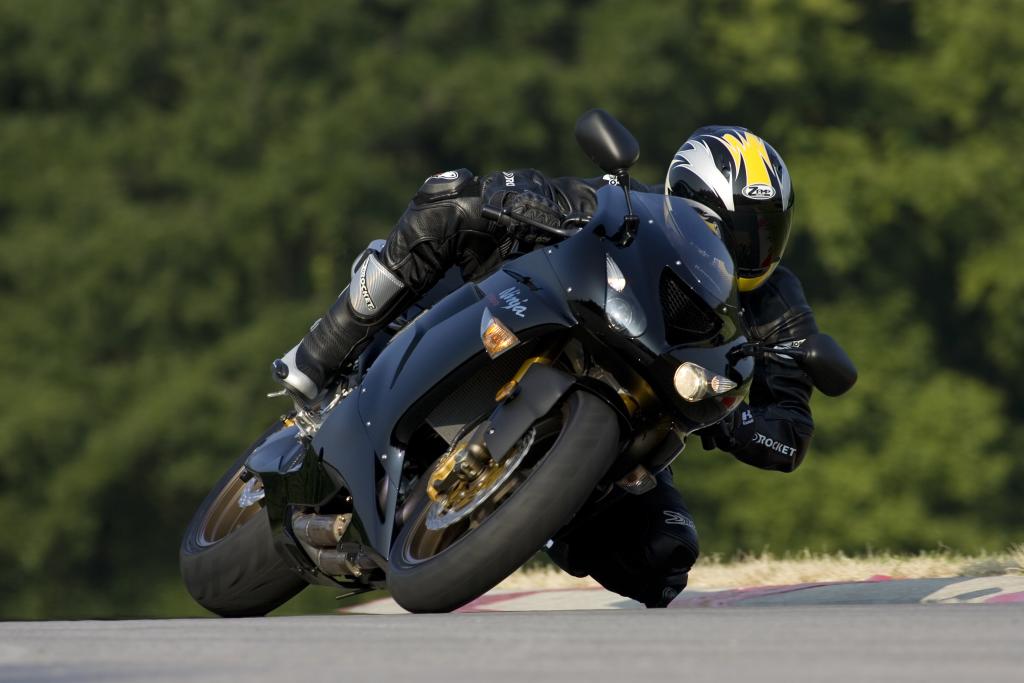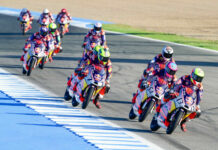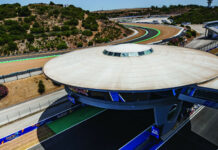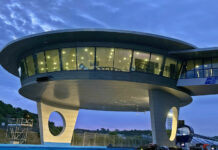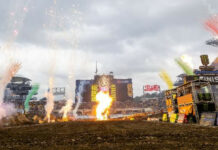2006 NINJA ZX-10R: A LESSON THAT PROVES THE BEST CAN ALWAYS BE BETTER Engineers and designers pull out all of the stops in keeping this award winner at the top of the class. Few would have thought Kawasaki engineers would tamper with the success enjoyed by its NINJA ZX-10R sportbike over the past two years. Having been named by Cycle World as the Best Superbike of both 2004 and 2005, it would have been easily accepted by the most hardcore of racetrack motorcyclists if Kawasaki had simply rested on its laurels. But, in a move intended to show the brand’s very serious and ongoing commitment to building the most potent motorcycles available, Kawasaki has taken it up another notch with the introduction of this latest version of the NINJA ZX-10R. Designed for the rider who feels at home in racing leathers, the new liter-class Kawasaki is being brought to market with a complete engine, chassis and aerodynamic makeover, maintaining its top-of-class dominance, whether on the street or racetrack. It features all new power characteristics, highlighted by a new fuel injection system featuring ultra-fine atomizing injectors to work with the 43mm throttle bodies and dual throttle valves. Providing a noticeable boost in mid-range power, the new ZX-10R’s power delivery is also more linear, and its off-corner acceleration capability will satisfy the most demanding of riders. Also contributing to the smoother power delivery is the addition of a heavier flywheel, and high-speed generator moved to the end of the crankshaft. Shifting gears while handling the bike’s awesome power output is simplified by improvements to the shift linkage, resulting in smooth, almost effortless transitions. By repositioning the ZX-10R’s center of gravity, Kawasaki engineers have bettered an already superb handling motorcycle. The new frame also features revised stiffness balance, new motor mounts, more centralized mass, and a relocated swingarm pivot, coupled with a racing-spec Ohlins steering damper. All told, a track-ready handler that is destined to surprise all who put it through its paces. Combining a short wheelbase with a long swingarm gives the ZX-10R the type of track maneuverability that speaks to its nimble, yet stable handling performance. And even more to the liking of experienced racers, the tucked-in position made so comfortable by the NINJA’s concave tank top and the relationship between pegs, handlebar, and seat, only magnifies its appropriateness for the track. How to package all of this potency into a look that virtually screams? Aggressive race-readiness was a question Kawasaki’s design team approached seriously. Aerodynamic performance quickly became the key to their search for a style befitting this new ZX-10R. Possessing an abundance of power, handling, and performance characteristics, the “look” of the motorcycle need only compliment its core consumer values. The designers focused on a no-frills approach to delivering an experience that significantly improves aerodynamics with a new fairing, seat cowl, and dual under-seat exhaust system. While the most noticeable effect of this new look is found at the high end of the speedometer, it succeeds in appearing fast, even when sitting still. Detailing the makings of a champion’s Superior Cornering Performance: Finding the right mix of raw power, braking, and handling delivers what Kawasaki engineers recognize is the true meat of a racer’s success: corner exit speeds that dictate ultimate straightaway speeds. Working with the company’s test riders, they combined years of racing and superstock machine development to devise ways to improve this all-important facet of the motorcycle’s performance. The 10R’s chassis was scrutinized like no other, including measurements for both kinetic and static centers of gravity. The power curve was redesigned to deliver more in the mid-range as well as more linear power across the entire rpm spectrum. 2006 NINJA ZX-10R Track-tuned chassis: o Repositioning the engine so the crankshaft is slightly higher and in tune with the frame modifications results in a higher center of gravity and improved mass centralization. In turn, the new center of gravity for the ZX-10R improves the roll response, particularly important when taking it through a series of esses or when returning it to a vertical position as the rider exits a corner. o Raising the center of gravity necessitated changes to the engine, as well. The cylinder bank angle has been reduced from 20 degrees to 23 degrees, the ACG moved from behind the cylinders to the crankshaft end, and the starter clutch moved from the left to the right side cover, while the starter is located behind the cylinders. This relocation allowed the engineers to avoid an increase in engine width, thus helping to maintain a very desirable 52 degree bank angle. o The wheelbase is unchanged, despite moving the steering head forward and the change in frame geometry. o This new frame employs new castings in the steering head area and uses rigid engine mounts’ both positively affecting the frame’s stiffness balance. o The new swingarm uses castings around the pivot area and pressings for the beams and stabilizer. Engineers raised the swingarm pivot location and that change, combined with the use of a larger rear tire (190/55ZR17) provides optimum traction coming out of corners. o The ZX-10R has been outfitted with an adjustable Ohlins steering damper. Smooth power delivery: o First, second, and third gear torque output is key to ultimate performance, so controlling power delivery is of significant paramount. The engineers increased the crankshaft’s flywheel mass to offer greater stability on corner entry. This increased mass and the ZX-10R’s slipper clutch aid the overall effect. Acceleration out of corners is also improved as the heavier flywheel helps resist natural wheelie inclinations in first, second, and third gears. o Corner-exit acceleration also benefits from the increased linear power characteristics of the new engine and its stronger mid-range performance. o A new, round throttle pulley reduces throttle load and combines with revised ECU mapping to provide smoother transitional power characteristics when the rider applies gas coming out of a turn. While this feature has specific application in a racing environment, it also works when normal street riding calls for variations in throttle application. Impressive Power-to Weight Ratio: o The new ZX-10R combines the strength of its engine output, a stronger mid-range, and improved aerodynamic efficiency to deliver quicker acceleration off of turns as well as off the starting line. More power, less weight. o The NINJA ZX-10R’s liquid-cooled, DOHC 16-valve, 998cc engine benefits from new, ultra-fine atomizing injectors, as mentioned earlier. Improved fuel atomization boosts combustion efficiency for greater power output, more linear power delivery and a smooth, step-free torque curve. o The new, lightweight Denso radiator has tightly packed cores for improved cooling. o Weight is further reduced by using a new, die-cast, one-piece seat rail. o The realignment of the engine, as mentioned earlier, provides a gain in power while reducing engine weight. Improved Aerodynamic Performance: o When a rider ventures into the upper speed ranges in a track environment, aerodynamics can easily provide the difference in competitive lap times, or more directly, in a podium finish. Kawasaki engineers and designers determined to deliver a motorcycle for the rider seeking an all-business approach to victory. The ZX-10R shines in those upper speed ranges. The new fairing, seat cowl, and dual under-seat exhaust system deliver not only significantly improved aerodynamic qualities, but riding thrills unlikely to be found elsewhere. o New, extremely light and compact projector beam headlights allowed the design freedom to create the more aerodynamic cowl as well as a more efficient Ram Air duct. o A reshaped rear seat cowl improves airflow around the back of the ZX-10R, reducing turbulence that causes drag. o The new dual under-seat exhaust also serves to minimize drag by eliminating the turbulence typically associated with muffler positioning. o By integrating the front and rear turn signals into the fairing, wind resistance is further minimized. And when the ZX-10R owner is effortlessly carving a path around the racetrack, it’s nice to know how easy Kawasaki has made it to keep an eye on progress. An all new hybrid instrument cluster provides quick, easy-to-read updates on the 10R’s operating conditions. By using newly available technology, the instrument cluster gives the illusion of being further away, making it easier for the eyes to change focus. The new layout features an analogue tachometer and a digital speedometer, both illuminated from the rear with an adjustable LED glow, giving the rider four options of brightness. Kawasaki has kept the lap timer and clock functions that previously were part of the cluster. o Adding to the NINJA ZX-10R’s stable of race-ready features, the engineers worked with Ohlins to create an adjustable steering damper unit with a relief valve and twin-tube design. The second tube acts like a reservoir tank, and the damper internals help ensure stable damping performance, even under the demands of a race course environment. And the envelope, please… Anyone who’s experienced the NINJA ZX-10R’s awesome performance in the past two years will likely find the 2006 version of Kawasaki’s now-perennial award winner an amazing engineering accomplishment. Yes, it incorporates new technologies, and thoroughly refines others. But, at its core, this is a motorcycle built for the accomplished rider who can fully appreciate these improvements; whether put to the test at a racetrack, or merely the focus of bench-racing conversation. It is, by all standards, the embodiment of the ultimate superbike. Kawasaki Motors Corp., U.S.A. (KMC) markets and sells at wholesale Kawasaki motorcycles, ATVs, personal watercraft and utility vehicles through a network of more than 1,500 independent retailers, with an additional 8,400 retailers specializing in power products and general purpose engines. KMC and its affiliates employ nearly 2,400 people in the United States, with more than 350 of them located at the Irvine, California headquarters. Kawasaki’s tagline, ‘Let the good times roll’, is recognized worldwide and the brand is aggressively carrying its heritage of leading-edge power, performance and exhilaration into the 21st century. Information about Kawasaki’s complete line of recreational products and Kawasaki affiliates can be found on the Internet at www.kawasaki.com.
Shocker: Kawasaki ZX-10R Now Has Analog Tach
Shocker: Kawasaki ZX-10R Now Has Analog Tach
© 2005, Roadracing World Publishing, Inc.
